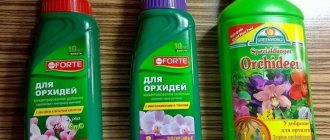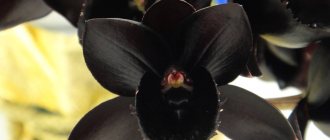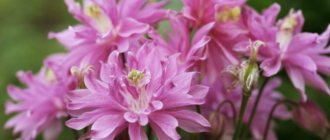Most moisture-loving plants are native to the hot, green tropics and jungles. Epiphytes are no exception, the most common representatives of which are the fascinating orchids.
An unusual fact is the spread of orchids not only in the humid tropics, but also on beaches, stony mountains, tundras and semi-deserts. It is easy to guess that their appearance, due to adaptation to living conditions, differs from the epiphytic orchids we are used to growing in indoor pots.
Description and photo
The Narbonne orchid, or Phalaenopsis Anthura Narbonne, a member of the orchid family, has a red veined color.
The color of the petals is predominantly salmon, coral, tomato, and terracotta.
Refers to a type of indoor flowers and plants.
- The length of the inflorescence is 20-25 cm.
- Leaf size – 15-20 cm.
- Sheet width – 7.5-10 cm.
- Plant height – 50-60 cm.
The color of the leaves is approaching dark green.
Photo of Phalaenopsis Anthura Narbonne orchid:
The primary color of the edge is red, the secondary color is yellow, ocher.
Flowering period
Flowering is long-lasting: with proper care it lasts 2–3 months. After which there is a break of 50–60 days. In winter, it is not recommended to stimulate the release of flowers; it is important to give the crop a rest.
Only proper care and provision of optimal conditions can lead to flowering. Sometimes buds do not appear for a long time, which indicates a stressed state of the plant. It is important to review and adjust all points of care (they will be described in the article below).
If an orchid produces a bud but suddenly drops it, it means that the crop was attacked by pests or the growing conditions changed.
Benefits and harms
The orchid rhizome, which has the shape of a bulb, has medicinal properties . In folk medicine, people have also learned to use the leaves of the plant to treat colds. Together, the rhizome and leaves gave an excellent effect in treatment:
- burns and their consequences;
- eliminating the inflammatory process;
- treatment of abscesses.
The plant was also used:
- for the production of tonic tinctures;
- as an immune stimulant;
- as a means to improve the functioning of the gastrointestinal tract.
The plant does not cause any harm and is not poisonous . May cause an individual reaction in the form of an allergy.
Since ancient times, parts of the orchid have been eaten, oils and perfumes have been made from it, but none of the above has caused negative consequences.
Priming
Substrate for planting and transplanting orchids can be purchased at the store.
It is also fashionable to grow orchids using hydroponics. The most common material for planting orchids is expanded clay . Its advantage is accessibility and cost-effectiveness. The structure of expanded clay is similar to bark, but its disadvantage is the accumulation of salts if the composition is incorrectly chosen.
The best option for an orchid would be environmentally friendly garden substrate expanded clay made from high quality clay. The main advantage of expanded clay is its ability to retain moisture after watering and release it to the plant in the right amount, which eliminates harmful stagnation of water.
For planting, choose transparent containers and cut drainage holes on the sides.
An excellent soil option for beginners would be ceramis , which can greatly facilitate the care of a demanding plant and even revive it. Seramis is a mixture of clay balls that imitates soil. Allows the root system to breathe, take in moisture and nutrients, and significantly reduces the risk of developing diseases.
Care instructions
Selecting a location
Phalaenopsis Kaoda is best placed on windowsills on the western and eastern sides to avoid direct sun, this is dangerous for the orchid. It is desirable that the lighting does not deprive this special flower of soft, warm shades, leaving only dark silhouettes - spots, because Kaoda petals are dense, not transparent, they will simply fade in unfavorable lighting.
Preparing the soil and pot
- Pot. It is recommended to grow this plant in pots or wooden slatted baskets. The diameter of the pot is usually average, up to 12 cm.
- Substrate:
- The base is medium-sized pine bark or coconut chips.
- You can put sphagnum moss on the surface of the substrate to dry out the roots.
- Moss serves as an indicator for watering time. When it has dried to a “crunch”, after 1 - 2 days the orchid needs to be watered.
- Good drainage is required for air circulation to prevent the roots from rotting.
- Sometimes peat is added to keep the substrate from becoming saline.
Temperature
Kaoda orchid loves warmth and soft light; moderate temperature conditions are desirable. The most optimal temperature in hot summer is 24 – 32°C, in winter the permissible temperature range is 16 – 22°C.
Humidity
In terms of air humidity, this phalaenopsis is quite patient and flexible, but humidity below 40 - 45% is undesirable. In summer we increase the humidity; regular spraying of the flower is recommended. In this case, you should avoid getting water on the flowers and buds.
TIP: You can humidify the air by pouring water into additional containers and placing them near the pots.
Lighting
Lighting is standard, as for all phalaenopsis, partial shade, without access to direct sunlight. Blooms well and grows in completely uniform artificial light. In spring and summer. Bright diffused light.
The orchid does not tolerate direct bright sun. Do not expose the leaves to the risk of burns; monitor the lighting.
Watering
Watering directly depends on how the orchid is kept and the season. When planting Kaoda on a block, you need to water it every day, especially on hot summer days. If the orchid grows in a pot or basket, it needs to be watered once every 5 to 7 days. This variety is very resistant to drying and can remain unwatered for a long time.
During watering, carefully protect the rosettes and leaf axils so that water does not get there. Stagnation of water in these places can lead to rotting and further death. Immediately after watering, you can place the orchid under a fan, then all excess moisture will evaporate and will not cause harm.
- In spring and hot summer. Once a week, spill the soil with warm water on top of the pot, preventing water from accumulating. Soaking in water is not recommended. It is best to water in the morning. It is necessary to water only when all the roots have become a uniform silver-gray color.
- In autumn and winter. More rare and careful watering, approximately once every 10-14 days.
Watch a video about proper watering of an orchid:
Top dressing
- Fertilizer is usually combined with watering to ensure even distribution of nutrients.
- Fertilizing is applied every 2 - 3 weeks during active growth of leaves and roots.
- It is better to use organic fertilizers.
- Flowering plants are not fertilized so that the buds do not fall off, and the orchid blooms longer.
- Once a month we feed with fertilizers for orchids, strictly following the instructions.
Watch a video about proper feeding of an orchid:
https://youtube.com/watch?v=6DdQe_D6_20
Transfer
We replant the orchid when the substrate begins to decompose. If you planted an orchid in the bark, the “shelf life” of the soil usually expires after 2-3 years. Transplantation is desirable when the plant “sits” very tightly in the pot, it is cramped, the pot is “overflowing” with roots on all sides.
Watch a video about proper orchid transplantation:
Planting (growing from seeds)
Orchid seeds look like cream-colored dust and ripen in capsules, each containing 4 million seeds. Orchid seeds do not have nutrients, so they live in symbiosis with fungi.
To successfully grow an adult orchid, the plant must first be pollinated, then carefully collect the ripe seeds.
Step-by-step instruction:
- Purchase jars with tight-fitting lids.
- Preparation of nutrient substrate. 15 g of agar-agar is poured into 250 ml of water for several hours. Add 10 g of glucose and fructose, agar-agar, to boiled water. The solution is stirred in one direction.
- Heat the mixture in a water bath until it becomes jelly-like.
- Distribution into jars of 30 ml each.
- The jars are tightly closed with a lid and sterilized within half an hour.
- Next, the containers should be left for 4-5 days.
- The seeds are disinfected with 2% peroxide for 10 seconds, after which they are transferred to jars.
- After about a year, the sprouts are transplanted into prepared soil made from crushed bark, moss and activated carbon; transplantation occurs by carefully twisting the sprouts from the substrate in a circular manner.
- Further care as for an adult plant.
Conditions of detention
The Kaoda Twinkle Orchid is a year-round flower.
This means that it can bloom its buds at any time of the year, regardless of nature and weather. Flowering usually occurs over a long period, but more often in the spring. Before releasing flower stalks on Coada, you need to care for it as standard. After flowering has ended, you need to cut off the flower shoots and give them semi-monthly or monthly rest. During this period, there is no need to overwater or fertilize the plant. Watering should be kept to a minimum and fertilizer should be eliminated altogether. Phal Kaoda Twinkle is very capricious in its care, and if it is incorrect, then during the flowering period, it may not produce buds at all.
Attention!
A sign of non-flowering can be a signal of improper care in temperature, watering, lighting. If there are no buds, then you should give Koada a month of peace and rest. During this time, it will gain strength and will be ready to release the arrow.
For Koada to bloom, you need to comply with all the conditions for its care:
- proper watering;
- humidity;
- temperature;
- lighting;
- feeding;
- transplants.
Soil and temperature
It is better to place the orchid on window sills in the eastern or western part of the room. The place should be well ventilated and lit, but not exposed to direct sunlight. The wind should not ventilate the room too much, otherwise the plant may get sick.
An orchid pot can be made of any material, but it is preferable that it be transparent with a small diameter of about 15-17 centimeters. A transparent pot is useful because the plant can participate in photosynthesis. It is best if the container has soft and smooth walls, otherwise the roots will grow into the surface. The soil should be purchased ready-made, which is intended for orchids. But you can cook it yourself. For this you need:
- sphagnum moss;
- pine bark;
- river sand;
- peat.
All components must be mixed in equal portions. The temperature should vary depending on the time of year. In summer, 26-32 degrees Celsius. In winter you need to reduce it to 15-21 degrees.
Advice.
Do not place the orchid near stoves, radiators or heaters in winter. This can cause dry flowers.
Humidity and lighting
Coad's homeland is tropical forests, where there is always high humidity. During the day and evening there is light rain and fog in the morning.
The orchid should always be well hydrated. You can do this in the following ways:
- humidifier;
- tray with water;
- normal watering in accordance with Coada requirements.
You can place a pot, a mug, or any container with water nearby to moisten the flower.
Watering depends on the conditions and climate where the plant is grown. For it to be correct, you need to look at the condition of the soil and the color of the roots. The roots when dry are close to silver in color. And the substrate should be kept dry for 2-3 days.
Fertilizing should be done no more than twice a month. It is recommended to fertilize during the period of active growth of Coada. When flowering occurs, fertilizing is not needed. To make it complete and correct, it is better to use complex fertilizers for orchids.
A remedy that makes plants grow by leaps and bounds! Just water your plants with this Read more…
Any flower from the orchid family loves light. But you need to know that these should not be direct scorching bright sunlight, but diffused light. In the hot summer, it is better to hide the plant in the shade, preventing it from drying out. At any other time, simply provide the correct lighting so that the flower does not dry out and burn the leaves. In winter, it will likely be necessary to resort to artificial lighting to provide Kaode with at least 10 hours of light per day.
Transplantation and propagation
Transplantation is only needed when necessary. For example, if the horses begin to rot or the pot becomes small, new shoots begin to bloom. To replant a plant, you need to choose a pot, fill in new fresh soil, move the flower, dig it well and divide it, if necessary, so that the roots have good free space.
Note. Coada orchid reproduces by separating new shoots of “babies” from the main stem
The Coada orchid reproduces by separating new shoots of “babies” from the main stem.
This must be done carefully and carefully, observing all the conditions for new plants:
- temperature, which should not be lower than 26 degrees Celsius;
- humidity, which should be no more than 60 percent.
Care
The first two weeks of staying in a new place are quarantine (lack of direct sunlight, watering and fertilizers).
Temperature
Maintaining optimal temperature in summer – +22 C, in winter – +12-15 C.
Lighting
The light is diffused, it is advisable to stay in the shade in summer, and on a windowsill in winter.
Watering
Moderate without flooding, which will be facilitated by high-quality drainage to eliminate excess moisture and a container with drainage holes.
Top dressing
The best choice for fertilizer would be special products created for epiphytes.
Good store-bought options are Tsitovit, Agricola, Flower Paradise and fertilizers containing phosphorus, nitrogen, potassium and other microelements.
Trimming
Regular pruning is a decisive factor for the health of the plant. Pruning is done after flowering is complete , or if resuscitation is necessary.
Transfer
The optimal time for replanting is after complete flowering, usually in late spring or summer, with complete preservation of the root system.
Caring for phalaenopsis at home
- Lighting. Phalaenopsis Narbonne prefers bright, but diffused light. The plant can be installed on the eastern or southern sides of the room. It is important to ensure that the midday rays do not burn the crop. To do this, it is recommended to protect it with a screen made of a regular white sheet of paper.
- Humidity. Since phalaenopsis is a continental crop, it needs to be provided with high air humidity (within 60–65%). To do this, place a container of water next to the flowerpot or place moistened moss in the tray. You can only spray the air around it; it is not recommended to spray the phalaenopsis itself, since drops of water can get into the leaf and root rosettes, which will cause rotting.
- Temperature. The optimal temperature for phalaenopsis ranges from 22–25 degrees above zero. For the full development of the crop, including regular abundant flowering, it is important to withstand daily temperature changes. It is approximately 4–6 degrees. The main reason for the lack of flowering is precisely the failure to observe the difference in daily temperature. In winter, Phalaenopsis Narbonne begins a resting phase, so daytime temperatures are reduced by 7–9 degrees, and night temperatures by only 2–3.
- Watering. Soil moisture should be plentiful, but infrequent. Before watering the crop again, you need to make sure that at least a third of the entire substrate is dry. For irrigation, choose settled water; rain water is also suitable. It is not recommended to boil water before moistening the soil, as it will lose most of the nutrients and minerals. An hour after watering, excess water is drained.
- Substrate. Beginning flower growers are not recommended to experiment with the composition of the soil; they are suitable for a ready-made mixture intended specifically for the orchid family. More experienced gardeners prepare the soil mixture themselves. It consists of turf and leaf soil, sphagnum moss, and tree bark. Be sure to add a drainage layer to the soil - this can be brick chips, small pebbles, or pieces of foam plastic.
- Transfer. During the first 2–3 years of development of Phalaenopsis Narbonne, it must be replanted every year. Transplantation is carried out in early spring after the dormant period ends. In the future, the frequency of changing the pot and soil depends on the growth of the root system. The pot should be 1–2 cm larger than the volume of the rhizome. A container that is too spacious will result in the crop growing its root mass for a long time, and the above-ground part will stop developing.
- Reproduction occurs with the help of shoots - children, as well as by dividing the rhizome. The first method is easier. It is enough to wait until a shoot appears, and at least small roots appear on it. After this, the baby is carefully cut off with a sharp, disinfected knife and transplanted into a separate container. In the first week, greenhouse conditions are maintained, gradually adapting the young plant to normal conditions.
You can watch the flowering and get some tips on caring for the variety in the video:
Find out interesting things about other groups and varieties of phalaenopsis: Big Lip, Golden, Wild Cat, Stone Rose, Kimono, Cleopatra, Legato, Liodoro, Manhattan, Mix, Mini, Multiflora, Parrot, Ravello, Sogo, Surf Song, Frontera, Charmer, Chengdu , Schiller
The Phalaenopsis Narbonne orchid is an unusual plant that captivates at first sight. It develops and blooms well if all the above conditions are met. At the same time, care does not take much time.
Reproduction
Propagation of the Narbonne orchid is carried out:
- By cuttings (by separating the top of a plant or peduncle from the mother).
- A shoot (appears naturally). The shoot is located at the base of the root of an adult plant, on the peduncle or stem of the mother plant.
- Peduncle (appears at the place where the leaf is connected to the stem, looks like a root).
- Seeds (formed in boxes on inflorescences).
Diseases and pests
Fractures on the leaves can be mistaken for a disease, but these are only the consequences of injury, infrequent watering or excess nitrogen.
Diseases:
- Viral mosaic disease . The disease is expressed in the appearance of black spots with a white rim on the leaves. Unfortunately, no home remedies have yet been found to treat this disease.
- Fungal diseases . Signs of fungal diseases of orchids include yellowed leaves and black spots on them, rotting leaf bases, and gray rot. Basically, fungal diseases are treated by treating the location of the flower pot with a 10% solution of sodium hypochloride or a 25% solution of any detergent that contains active oxygen.
- Aphids, mealyworms and scale insects . An effective way to combat such pests is the use of folk remedies. A solution of 1 liter of water, tbsp. l. salt, tbsp. l. soda and 10 grams of household liquid were sprayed on the plant.
Step-by-step care instructions
Selecting a location
This orchid is very afraid of the open rays of the sun. Experienced collectors advise placing it on northern windows, adding lighting.
Preparing the soil and pot
It is better to take a transparent plastic pot; we make small holes in the sides and bottom for good air access and for a comfortable location of the roots. The pot should not be very large, it should serve as support for the roots, so choose medium-sized pots.
Substrate:
- Drainage - place pieces of polystyrene foam or expanded clay on the bottom of the pot.
- Charcoal - crushed pieces can be placed directly into the moss between the roots.
- Sphagnum moss retains moisture well and is a natural environment for orchids.
- Medium pieces of pine bark, peeled and well washed, can be disinfected: boiled or soaked in boiling water.
Temperature
The orchid is heat-loving; it is advisable that the temperature does not fall below 20 °C during the day, no matter what time of year it is outside. Then it will develop well, grow, produce young leaves, and soon it will bloom again.
IMPORTANT: Sogo orchid does not like heat, the optimal temperature is up to 28°C
Humidity
Sogo orchids do not require too much moisture, 50 - 60% is enough. They tolerate drying better than flooding. But in spring and summer, it is necessary to increase air humidity. This will ensure good growth and flowering of the orchid.
Additional moisture is not required; it is enough to simply refresh the leaves in hot weather by spraying. After spraying, dry the leaves, axils and rosettes well so that no water remains in them, this is very dangerous for our orchid.
Lighting
The Sogo orchid, like all hybrid varieties of phalaenopsis, is not capricious. Does not require any special lighting devices. In spring and summer, be sure to darken the windows so that the sun does not burn the orchid leaves. In winter, additional lighting is required; special phytolamps can be used.
Watch a video about lighting orchids and additional lighting:
Watering
If the orchids are located on northern windows, naturally, watering here is not as frequent as if the orchids were located on a “warmer” window
It is important to watch the roots. If the roots become grayish-brown, you can water them. It is better not to irrigate or spray the flowers, so that spots do not appear on them, but you can spray them over the leaves, while also moisturizing the aerial roots
Once every 2 weeks is enough in the autumn-winter period, and if it is very hot, then once a week
It is better not to irrigate the flowers, not to spray them, so that spots do not appear on them, but you can spray them over the leaves, while also moisturizing the aerial roots. Once every 2 weeks is enough in the autumn-winter period, and if it is very hot, then once a week.
It is important to water only when the substrate is dry. It is better to water before lunch, so that by evening the substrate will dry out a little and the excess moisture will evaporate. At night, the air temperature naturally drops, and this can harm wet roots - they can rot
At night, the air temperature naturally drops, and this can harm wet roots - they can rot.
Watch a video about proper watering of an orchid:
Top dressing
The Sogo orchid is usually fed along with watering. Flower growers advise watering with any special rooting agent for orchids. Fertilizer mode: alternating watering with plain water and watering with fertilizer.
As soon as the buds appear, water only with water, without fertilizer. The main thing is to do no harm.
Transfer
You purchased a young orchid - it is better to transplant it immediately:
- First carefully remove from the pot.
- Soak the orchid together with a lump of earth in a solution of epin and succinic acid.
- We also soak coconut chips and sphagnum moss.
- We replant using the transshipment method, with the original substrate (if the orchid is healthy).
- If there are diseased, rotten roots, then root cleaning will be required.
- We also clean the already soaked flower from old moss with tweezers, especially if the substrate has become loose and has become very dense, it needs to be loosened and stirred.
- There should be enough space for the roots.
- Before planting, leaves and pre-root areas, roots can be sprayed with a solution of 3% hydrogen peroxide to prevent disease.
- Mix moss with charcoal or regular activated carbon.
- We lower the renewed and treated orchid into a new pot.
- It’s easy to use the finished substrate, don’t push it, and fill the space of the pot.
- Place the orchid in a large container and water it well so that the moisture saturates the entire new substrate.
- Excess water will gradually drain through the holes.
- Use a cotton pad to remove water from the leaves and growing points to avoid rot.
ATTENTION: Leaf axils must be dried. https://www.youtube.com/embed/ohDmR6ethVU











